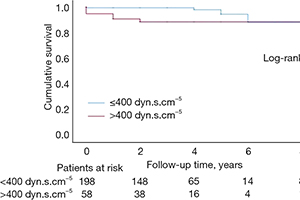Pulmonary thromboendarterectomy in chronic thromboembolic pulmonary hypertension: the Spanish experience
Abstract
Background: Chronic thromboembolic pulmonary hypertension (CTEPH) can be cured by pulmonary endarterectomy (PEA). It is considered the best and only curable treatment option for patients with accessible lesions evaluated as optimal candidates. We describe the experience of the two reference centers in Spain, in order to reinforce the need for referring CTEPH patients to a specialized center to be assessed by a Multidisciplinary Expert Team.
Methods: We included a population of 338 patients who met the definition for CTEPH and underwent PEA between January 2007 and December 2019. The surgery was indicated in almost 60% of patients assessed. Demographic, anthropometric, hemodynamic and echocardiographic features are listed for PEA patients. Immediate and one-year postoperative outcomes as well as overall mortality were analyzed.
Results: Mean age was 53.5±15.0 years, 53.8% were men; a total of 68.5% were in WHO functional class III–IV; and most of them were in a preoperative hemodynamic condition: mean pulmonary arterial pressure (mPAP) was 46.5±13.1 mmHg and mean pulmonary vascular resistance (PVR) was 764.5±392.8 dyn·s·cm−5. PEA surgery was performed with cardiopulmonary bypass (CBP) and circulatory arrest, with very few complications [including neurological, postoperative reperfusion edema, extracorporeal membrane oxygenation (ECMO) implant and cardiac failure] and optimal postoperative results, where exercise capacity increased and mPAP and PVR values decreased significantly. Presence of persistent pulmonary hypertension (PH) at the six-month right heart catheterization was evaluated. A 3.3% perioperative mortality was achieved. Overall, one-, three- and five-year survival rates were analyzed by Kaplan-Meier’s method (94.8%, 93.3% and 90.5% respectively), as well as for residual PH patients. Mortality risk factors were assessed.
Conclusions: Outstanding PEA results were seen in the immediate, one-year and long-term outcomes. The incidence of complications, including in-hospital mortality and long-term mortality were also below European rates.
Cover






